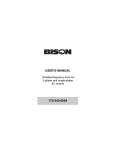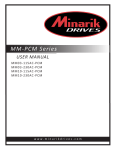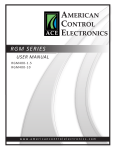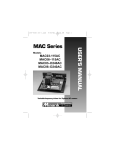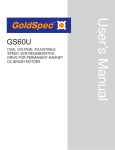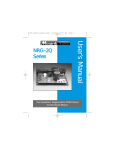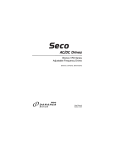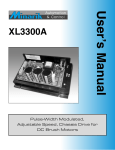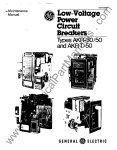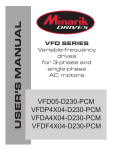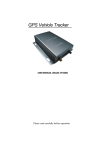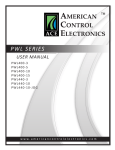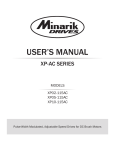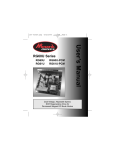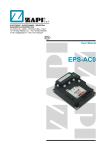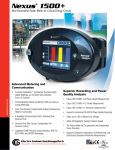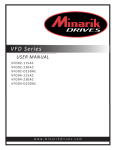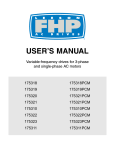Download USER MANUAL - Minarik Drives
Transcript
N R G - 4 Q S e r i e s USER MANUAL MODELS NRG02-D240AC-4Q NRG02-D240AC-4Q-PCM NRG05-D240AC-4Q NRG05-D240AC-4Q-PCM NRG10-115AC-4Q NRG10-115AC-4Q-PCM Four Quadrant, Regenerative PWM Drives For DC Brush Motors Copyright © 2005 by Minarik Corporation All rights reserved. No part of this manual may be reproduced or transmitted in any form without written permission from Minarik Corporation. The information and technical data in this manual are subject to change without notice. Minarik Corporation and its Divisions make no warranty of any kind with respect to this material, including, but not limited to, the implied warranties of its merchantability and fitness for a given purpose. Minarik Corporation and its Divisions assume no responsibility for any errors that may appear in this manual and make no commitment to update or to keep current the information in this manual. Printed in the United States of America. i Safety Warnings • This symbol l denotes an important safety message. Please read these sections very carefully before performing any calibration, repair, or other procedure contained in this manual. • Have a qualified electrical maintenance technician install, adjust, and service this equipment. Follow the National Electrical Code and all other applicable electrical and safety codes, including the provisions of the Occupational Safety and Health Act (OSHA), when installing equipment. • Reduce the chance of an electrical fire, shock, or explosion by proper grounding, over current protection, thermal protection, and enclosure. Follow sound maintenance procedures. L It is possible for a drive to run at full speed as a result of a component failure. Minarik strongly recommends the installation of a master switch in the main power input to stop the drive in an emergency. Circuit potentials are at 120 VAC or 240 VAC above earth ground. Avoid direct contact with the printed circuit board or with circuit elements to prevent the risk of serious injury or fatality. Use a non-metallic screwdriver for adjusting the calibration trimpots. Use insulated tools if working on this drive with power applied. ii Contents Specifications . . . . . . . . . . . . . . . . . . . . . . . . . . . . . . . . . . . . . . . . . . . . . . . .1 Dimensions . . . . . . . . . . . . . . . . . . . . . . . . . . . . . . . . . . . . . . . . . . . . . . . . . .4 Installation . . . . . . . . . . . . . . . . . . . . . . . . . . . . . . . . . . . . . . . . . . . . . . . . . .5 Mounting . . . . . . . . . . . . . . . . . . . . . . . . . . . . . . . . . . . . . . . . . . . . . . .5 Wiring . . . . . . . . . . . . . . . . . . . . . . . . . . . . . . . . . . . . . . . . . . . . . . . . . .6 Shielding guidelines . . . . . . . . . . . . . . . . . . . . . . . . . . . . . . . . . . .7 Speed adjust potentiometer . . . . . . . . . . . . . . . . . . . . . . . . . . . . . . . . . .8 Heat sinking . . . . . . . . . . . . . . . . . . . . . . . . . . . . . . . . . . . . . . . . . . . . .9 Line fusing . . . . . . . . . . . . . . . . . . . . . . . . . . . . . . . . . . . . . . . . . . . . . .9 Cage-clamp terminals . . . . . . . . . . . . . . . . . . . . . . . . . . . . . . . . . . . . .10 Connections . . . . . . . . . . . . . . . . . . . . . . . . . . . . . . . . . . . . . . . . . . . . .11 Power input connections Motor connections . . . . . . . . . . . . . . . . . . . . . . . . . . . . . .11 . . . . . . . . . . . . . . . . . . . . . . . . . . . . . . . . . . .12 Regenerative dump resistor connections . . . . . . . . . . . . . . . . . . .12 Top board terminals . . . . . . . . . . . . . . . . . . . . . . . . . . . . . . . . . .14 Signal and optional switch connections Speed adjust potentiometer connections . . . . . . . . . . . . . . . . . . . . . . . .16 . . . . . . . . . . . . . . . . . . . . . . .18 Voltage follower . . . . . . . . . . . . . . . . . . . . . . . . . . . . . . . . . . . . .19 Slide switches . . . . . . . . . . . . . . . . . . . . . . . . . . . . . . . . . . . . . . . . . .20 ARMATURE VOLTAGE OUT (SW501) . . . . . . . . . . . . . . . . . . . . .20 FEEDBACK SELECT (SW502) Headers . . . . . . . . . . . . . . . . . . . . . . . . . .20 . . . . . . . . . . . . . . . . . . . . . . . . . . . . . . . . . . . . . . . . . . . . . . .20 INHIBIT PERSONALITY (JMP501) . . . . . . . . . . . . . . . . . . . . . . .20 CONTROL MODE (JMP502) . . . . . . . . . . . . . . . . . . . . . . . . . . . .21 INHIBIT MODE (JMP503) . . . . . . . . . . . . . . . . . . . . . . . . . . . . . .21 CURRENT LIMIT OUT (J502) . . . . . . . . . . . . . . . . . . . . . . . . . . .21 OUTPUT HEADER (J504) . . . . . . . . . . . . . . . . . . . . . . . . . . . . . .22 Operation . . . . . . . . . . . . . . . . . . . . . . . . . . . . . . . . . . . . . . . . . . . . . . . . . 23 Before applying power Startup and shutdown . . . . . . . . . . . . . . . . . . . . . . . . . . . . . . . . . . . .23 . . . . . . . . . . . . . . . . . . . . . . . . . . . . . . . . . . . . .24 Contents Reversing the drive: . . . . . . . . . . . . . . . . . . . . . . . . . . . . . . . . . .24 Starting and stopping methods . . . . . . . . . . . . . . . . . . . . . . . . . . . . . . .25 Line starting and line stopping . . . . . . . . . . . . . . . . . . . . . . . . . .26 Automatic restart upon power restoration Decelerating to minimum speed . . . . . . . . . . . . . . . . . .26 . . . . . . . . . . . . . . . . . . . . . . . . .26 Inhibit terminals . . . . . . . . . . . . . . . . . . . . . . . . . . . . . . . . . . . . .27 Regenerative dump . . . . . . . . . . . . . . . . . . . . . . . . . . . . . . . . . . .28 Torque (Current) Control . . . . . . . . . . . . . . . . . . . . . . . . . . . . . . .31 NRG-4Q-PCM . . . . . . . . . . . . . . . . . . . . . . . . . . . . . . . . . . . . . . .31 Calibration . . . . . . . . . . . . . . . . . . . . . . . . . . . . . . . . . . . . . . . . . . . . . . . . .32 Calibration procedure . . . . . . . . . . . . . . . . . . . . . . . . . . . . . . . . . . . . .34 MINIMUM SPEED (MIN SPD) . . . . . . . . . . . . . . . . . . . . . . . . . . .35 INHIBIT OFFSET . . . . . . . . . . . . . . . . . . . . . . . . . . . . . . . . . . .36 INPUT OFFSET . . . . . . . . . . . . . . . . . . . . . . . . . . . . . . . . . . . . .37 FORWARD MAXIMUM SPEED (FWD MAX) . . . . . . . . . . . . . . . . .38 REVERSE MAXIMUM SPEED (REV MAX) REGULATION (IR COMP) . . . . . . . . . . . . . . . . .38 . . . . . . . . . . . . . . . . . . . . . . . . . . . . .39 MOTOR TORQUE LIMIT and REGEN TORQUE LIMIT . . . . . . . . .40 FORWARD ACCELERATION (FWD ACCEL) REVERSE ACCELERATION (REV ACCEL) TACHOMETER (TACH) . . . . . . . . . . . . . . . .42 . . . . . . . . . . . . . . . . .43 . . . . . . . . . . . . . . . . . . . . . . . . . . . . . . .44 Application Notes . . . . . . . . . . . . . . . . . . . . . . . . . . . . . . . . . . . . . . . . . . . .47 Connection to other Minarik devices . . . . . . . . . . . . . . . . . . . . . . . . . . .47 Optional speed adjust potentiometer connections . . . . . . . . . . . . . . . . .49 FWD-MIN SPD-REV Switch . . . . . . . . . . . . . . . . . . . . . . . . . . . .49 Independent Adjustable Speeds . . . . . . . . . . . . . . . . . . . . . . . . .50 Independent forward and reverse speeds . . . . . . . . . . . . . . . . . .51 Independent forward and reverse speeds using a FWD-MIN SPD-REV switch . . . . . . . . . . . . . . . . . . . . . . . . .52 Troubleshooting . . . . . . . . . . . . . . . . . . . . . . . . . . . . . . . . . . . . . . . . . . . . .53 Before applying power: . . . . . . . . . . . . . . . . . . . . . . . . . . . . . . . . . . . .53 iii iv Contents Diagnostic LEDs . . . . . . . . . . . . . . . . . . . . . . . . . . . . . . . . . . . . . . . . .54 CURRENT LIMIT . . . . . . . . . . . . . . . . . . . . . . . . . . . . . . . . . . . .54 MOTOR . . . . . . . . . . . . . . . . . . . . . . . . . . . . . . . . . . . . . . . . . . .54 REGEN . . . . . . . . . . . . . . . . . . . . . . . . . . . . . . . . . . . . . . . . . . .54 OVER VOLTAGE COAST . . . . . . . . . . . . . . . . . . . . . . . . . . . . . .55 CE Compliance . . . . . . . . . . . . . . . . . . . . . . . . . . . . . . . . . . . . . . . . . . . . . .60 Certificate of Compliance . . . . . . . . . . . . . . . . . . . . . . . . . . . . . . . . . .60 Compliance Requirements . . . . . . . . . . . . . . . . . . . . . . . . . . . . . . . . . .61 OEM Responsibility . . . . . . . . . . . . . . . . . . . . . . . . . . . . . . . . . .61 Installation . . . . . . . . . . . . . . . . . . . . . . . . . . . . . . . . . . . . . . . . .61 Enclosure Wiring . . . . . . . . . . . . . . . . . . . . . . . . . . . . . . . . . . . . . . . . .62 . . . . . . . . . . . . . . . . . . . . . . . . . . . . . . . . . . . . . . . . . . . .62 Grounding . . . . . . . . . . . . . . . . . . . . . . . . . . . . . . . . . . . . . . . . .62 AC Line Filters . . . . . . . . . . . . . . . . . . . . . . . . . . . . . . . . . . . . . .63 Unconditional Warranty . . . . . . . . . . . . . . . . . . . . . . . . . . . . . . . . . . . . . . .66 v Illustrations Figure 1. Four Quadrant Operation Figure 2. NRG–4Q Dimensions . . . . . . . . . . . . . . . . . . . . . . . . . . . . . . . . . .4 . . . . . . . . . . . . . . . . . . . . . . . . . . . . . . .x Figure 3. Speed Adjust Potentiometer . . . . . . . . . . . . . . . . . . . . . . . . . . . . .8 Figure 4. Cage-Clamp Terminal . . . . . . . . . . . . . . . . . . . . . . . . . . . . . . . . .10 Figure 5. Bottom Board Connections . . . . . . . . . . . . . . . . . . . . . . . . . . . . .13 Figure 6. Top Board Connections . . . . . . . . . . . . . . . . . . . . . . . . . . . . . . . .17 Figure 7. Speed Adjust Potentiometer Connections Figure 8. Voltage Follower Connections . . . . . . . . . . . . . . . . . . . . . . . . . . .19 Figure 9. Slide Switches, Headers and Terminals . . . . . . . . . . . . . . . . . . . .22 . . . . . . . . . . . . . . . . . .18 Figure 10. Regenerative Dump Circuit Connection . . . . . . . . . . . . . . . . . . . .30 Figure 11. Calibration Trimpot Layout Figure 12. Typical Motor Torque, Regen Torque and IR Comp Settings . . . . . . . . . . . . . . . . . . . . . . . . . . . . .33 for NRG02/05-4Q Series Drives . . . . . . . . . . . . . . . . . . . . . . . . .45 Figure 13. Typical Motor Torque, Regen Torque and IR Comp Settings for NRG10-4Q Series Drives . . . . . . . . . . . . . . . . . . . . . . . . . . .46 Figure 14. NRG–4Q Connection to DIGI-LOK Controls . . . . . . . . . . . . . . . . .47 Figure 15. NRG Connection to 200–0386A Limit Switch Logic Board . . . . . . .48 Figure 16. FWD / MIN SPD / REV Switch . . . . . . . . . . . . . . . . . . . . . . . . . . .49 Figure 17. Independent Adjustable Speeds (Forward Direction) . . . . . . . . . . .50 Figure 18. Independent Forward and Reverse Speeds . . . . . . . . . . . . . . . . .51 Figure 19. Independent Forward and Reverse Speeds Using a Figure 20. Diagnostic LED Location . . . . . . . . . . . . . . . . . . . . . . . . . . . . . . .56 Figure 21. CE Shielding, Ground and Filtering Connections . . . . . . . . . . . . .64 FWD / MIN SPD / REV Switch . . . . . . . . . . . . . . . . . . . . . . . . . . .52 vi Tables Table 1. Recommended Line Fuse Sizes Table 2. Inhibit Plug Harness Assembly . . . . . . . . . . . . . . . . . . . . . . . . . .9 Table 3. Regenerative Dump Resistor Values . . . . . . . . . . . . . . . . . . . . . .28 Table 4. AC Line Filters . . . . . . . . . . . . . . . . . . . . . . . . . . . . . . . . . . . . . .63 . . . . . . . . . . . . . . . . . . . . . . . . . .27 vii NRG–4Q Drives Minarik’s NRG–4Q Series drives are four-quadrant, regenerative PWM drives. These open chassis drives come with the following features: Pulse width modulation. Lower form factor than SCR drives (1.03 versus 1.37) throughout the motor speed range. Motor runs with greater efficiency and less maintenance. Four quadrant regenerative operation. see Regenerative drives section on page ix. Inhibit personality. Set the inhibit for your application needs: regenerative brake for fast stopping, or coast for slower stopping. Normally open or normally closed. On board fusing. Protects the drive from high line current. Cage-clamp terminals. Quicker and easier wiring than screw terminals. Regenerative braking. No contactors required. No electromechanical components to overheat or wear out. Reverse on the fly. Switch from forward to reverse instantaneously. Dual voltage input. Power the drive with either 120 VAC or 240 VAC. Autoranging power supply. Tachogenerator feedback option. Improve the speed regulation from approximately 1% (armature feedback) to 0.1% with tachogenerator feedback. viii NRG-4Q Drives Diagnostic LEDs. Allows easy visual inspection of the drive status. Motor, regen, current limit, and over voltage. +15 and –15 VDC supply (50 mA maximum capacity each). Power external devices with the drive’s power supply. User adjustable trimpots. Calibrate the drive precisely to your application needs. ix Regenerative Drives Most non-regenerative variable-speed DC drives control current flow to a motor in one direction. The direction of current flow is the same direction as the motor rotation. Non-regenerative drives operate in Quadrant 1, and also in Quadrant 3 if the drive is reversible (see Figure 1 on page x). Motors must stop before reversing direction. Unless dynamic braking is used, non-regenerative drives cannot decelerate a load faster than coasting to a lower speed. Regenerative drives operate in two additional quadrants: Quadrant 2 and Quadrant 4. In these quadrants, motor torque is in the opposite direction of motor rotation. This allows regenerative drives to reverse a motor without contactors or switches, to control an overhauling load, and to decelerate a load faster than it would take to coast to a lower speed. x Regenerative Drives Figure 1. Four Quadrant Operation 1 Specifications Model Number NRG02–D240AC–4Q (-PCM) Type AC Line Voltage Open Chassis 120 VAC or 240 VAC, ±10%, 50Hz or 60 Hz, single phase Maximum Continuous Armature Current 2 ADC Horsepower Range @ 130 VDC Output 1/20 – 1/4 Horsepower Range @ 240 VDC Output 1/10 – 1/2 Maximum Armature Voltage Range @ 120 VAC Input 0–130 VDC Maximum Armature Voltage Range @ 240 VAC Input 0–240 VDC Minimum Speed Adjustment Range @ 120 VAC Input 0–60 VDC Minimum Speed Adjustment Range @ 240 VAC Input 0–120 VDC Form Factor 1.05 Acceleration Time Range 0.1–20 seconds Deceleration Time Range 0.1–20 seconds Input Signal Range (signal must be isolated)** – 10 to +10 VDC Input Impedance Speed Regulation (% of base speed) 47k Ohm 1% open loop; 0.1% tach feedback Tachogenerator Voltage Output Range Vibration 7 V/1000 RPM to 50V/1000 RPM 0.5G max. (0–50 Hz); 0.1G max. (>50 Hz) Weight Ambient Operating Temperature Range* 1.9 lb 10°C–40°C *External air flow is required to ensure temperature limits are not exceeded. ** (-PCM) drives do not require an isolated signal. 2 Specifications Model Number NRG05–D240AC–4Q (-PCM) Type AC Line Voltage Open Chassis 120 VAC or 240 VAC, ±10%, 50Hz or 60 Hz, single phase Maximum Armature Current 5 ADC Horsepower Range @ 130 VDC Output 1/8 – 3/4 Horsepower Range @ 240 VDC Output 1/4 – 1.5 Maximum Armature Voltage Range @ 120 VAC Input 0–130 VDC Maximum Armature Voltage Range @ 240 VAC Input 0–240 VDC Minimum Speed Adjustment Range @ 120 VAC Input 0–60 VDC Minimum Speed Adjustment Range @ 240 VAC Input 0–120 VDC Form Factor 1.05 Acceleration Time Range 0.1–20 seconds Deceleration Time Range 0.1–20 seconds Input Signal Range (signal must be isolated)** – 10 to +10 VDC Input Impedance 47k Ohm Speed Regulation (% of base speed) 1% open loop; 0.1% tach feedback Tachogenerator Voltage Output Range Vibration 7V/1000 RPM to 50V/1000 RPM 0.5G max. (0–50 Hz); 0.1G max. (>50 Hz) Weight Ambient Operating Temperature Range* 1.9 lb 10°C–40°C *External air flow is required to ensure temperature limits are not exceeded. ** (-PCM) drives do not require an isolated signal. Specifications Model Number NRG10–115AC–4Q (-PCM) Type AC Line Voltage 3 Open Chassis 120 VAC, ±10%, 50Hz or 60 Hz, single phase Maximum Armature Current 10 ADC Horsepower Range @ 130 VDC Output 1/4 – 1.5 Maximum Armature Voltage Range @ 120 VAC Input 0–130 VDC Minimum Speed Adjustment Range @ 120 VAC Input 0–60 VDC Form Factor 1.05 Acceleration Time Range 0.1–20 seconds Deceleration Time Range 0.1–20 seconds Input Signal Range (signal must be isolated)** – 10 to +10 VDC Input Impedance Speed Regulation (% of base speed) 47k Ohm 1% open loop; 0.1% tach feedback Tachogenerator Voltage Output Range Vibration 7V/1000 RPM to 50V/1000 RPM 0.5G max. (0–50 Hz); 0.1G max. (>50 Hz) Weight Ambient Operating Temperature Range* 1.9 lb 10°C–40°C *External air flow is required to ensure temperature limits are not exceeded. ** (-PCM) drives do not require an isolated signal. 4 Dimensions TACH P509 IR COMP REGEN TORQUE MOTOR TORQUE REV ACCEL P505 P503 P504 P507 FWD ACCEL MIN SPD P501 P506 FWD MAX REV MAX P502 P510 1 +15 -15 S0 INHIBIT OFFSET MOTOR IL502 REGEN IL501 SW501 130 VDC S3 C503 S1 + C502 J502 S2 RB2 RB1 COM DIR - CURRENT LIMIT OUT ARMATURE VOLTAGE OUT 240 VDC JMP501 JMP502 INHIBIT PERSONALITY CONTROL MODE 1&2=VEL MODE 1&2=COAST 2&3=CUR MODE ARMATURE FEEDBACK 2&3=BRAKE 1 JMP503 IL504 CURRENT LIMIT 2 3 JMP502 2&3=NC 1 IL503 TACH/CUR MODE SW502 INHIBIT MODE 1&2=NO 2 3 JMP501 1 2 3 JMP503 INHIBIT OVER P511 T1 VOLTAGE COAST J504 T2 OUTPUTS 1=Iout 2=COM 12 INPUT 3=Yout 1 J501 2 3 OFFSET J504 Model Height (Dim. “A”) NRG02–D240AC–4Q (-PCM) 2.79 [71] NRG05–D240AC–4Q (-PCM) 3.13 [80] NRG10–115AC–4Q (-PCM) 3.62 [92] All dimensions in inches [millimeters] Figure 2. NRG–4Q Dimensions 5 Installation Mounting L Warning Do not install, rewire, or remove this control with input power applied. Doing so may cause fire or serious injury. Make sure you have read and understood the Safety Warnings on page i before attempting installation. The chassis must be earth grounded. Use a star washer beneath the head of at least one of the mounting screws to penetrate the anodized chassis surface and to reach bare metal. • Drive components are sensitive to electrostatic fields. Avoid direct contact with the circuit board. Hold drive by the chassis only. • Protect the drive from dirt, moisture, and accidental contact. • Provide sufficient room for access to the terminal block and calibration trimpots. • Mount the drive away from heat sources. Operate the drive within the specified ambient operating temperature range. • Prevent loose connections by avoiding excessive vibration of the drive. 6 Installation • Mount the drive with its board in either a horizontal or vertical plane. Preffered mounting is with fins vertical. Four 0.19 in. (5 mm) wide slots in the chassis accept #8 pan head screws. Wiring L V Warning Do not install, remove, or rewire this equipment with power applied. Doing so may cause fire or serious injury. Circuit potentials are at 120 or 240 VAC above ground. To prevent the risk of injury or fatality, avoid direct contact with the printed circuit board or with circuit elements. Do not disconnect any of the motor leads from the drive unless power is removed or the drive is disabled. Opening any one motor lead may destroy the drive. Do not fuse the motor line. • Use 18-24 AWG wire for speed adjust potentiometer wiring. Use 14–16 AWG wire for AC line (L1, L2) and motor (A1 and A2) wiring. Installation 7 Shielding guidelines L Warning Under no circumstances should power and logic leads be bundled together. Induced voltage can cause unpredictable behavior in any electronic device, including motor controls. As a general rule, Minarik recommends shielding of all conductors. If it is not practical to shield power conductors, Minarik recommends shielding all logic-level leads. If shielding logic leads is not practical, the user should twist all logic leads with themselves to minimize induced noise. It may be necessary to earth ground the shielded cable. If noise is produced by devices other than the drive, ground the shield at the drive end. If noise is generated by a device on the drive, ground the shield at the end away from the drive. Do not ground both ends of the shield. If the drive continues to pick up noise after grounding the shield, it may be necessary to add AC line filtering devices, or to mount the drive in a less noisy environment. Logic wires from other input devices, such as motion controllers and PLL velocity controllers, must be separated from power lines in the same manner as the logic I/O on this drive. 8 Installation Speed adjust potentiometer L Warning Be sure that the potentiometer tabs do not make contact with the potentiometer enclosure. Grounding the input will cause damage to the drive. Install the circular insulating disk between the mounting panel and the 10K ohm speed adjust potentiometer (see Figure 3). Mount the speed adjust potentiometer through a 0.38 inch (10 mm) hole with the hardware provided. Twist the speed adjust potentiometer wire to avoid picking up unwanted electrical noise. If potentiometer leads are longer than 18 inches (46 cm), use shielded cable. MOUNT THROUGH A 0.38 IN. (10 MM) HOLE CW WIPER CCW NUT STAR WASHER SPEED ADJUST POTENTIOMETER POT TAB ASSIGNMENTS INSULATING DISK PANEL Figure 3. Speed Adjust Potentiometer Installation 9 Heat sinking All NRG-4Q Series drives have sufficient heat sinking in their basic configurations. No additional heat sinking is required. Line fusing NRG Series drives have preinstalled line fuses. When replacing the line fuses, use fast acting fuses rated for 250 VAC or higher, and at least 200% of the armature current. See Table 1 for recommended line fuse sizes. Table 1. Recommended Line Fuse Sizes 90 VDC Motor 180 VDC Motor Max. DC Armature AC Line Fuse Horsepower Horsepower Current (amps) Size (amps) 1/20 1/10 0.5 3 1/15 1/8 0.8 3 1/8 1/4 1.5 5 1/6 1/3 1.7 5 1/4 1/2 2.6 8 1/3 3/4 3.5 8 1/2 1 5.0 10 3/4 - 7.6 15 1 - 10 20 10 Installation Cage-clamp terminals All connections are made to cage-clamp terminals. To insert a wire into the cage-clamp terminal: 1. Press down on the lever arm using a small screwdriver. Unnecessary force may cause damage. 2. Insert wire into the wire clamp. 3. Release the lever arm to clamp wire. Figure 4. Cage-Clamp Terminal Installation 11 Connections L Warning Do not connect this equipment with power applied. Doing so may cause fire or serious injury. Minarik strongly recommends the installation of a master power switch in the voltage input line, as shown in Figure 5 (page 13). The switch contacts should be rated at a minimum of 200% of motor nameplate current and 250 volts. Do not connect 240 VAC line voltage to terminal L2 (115). Fire or serious damage to the drive may result. Connect the power input leads and a DC motor to TB501 and TB502 on the drive’s printed circuit board (PCB) as shown in Figure 5 on page 13. Power input connections Connect the AC line voltage leads to terminals L1 and L2 on terminal board TB502, or to a double-throw, single-pole master power switch (recommended). If the line voltage is 120 VAC, connect the AC line voltage leads to terminals L1 and L2 (115). If the line voltage is 240 VAC, connect the AC line voltage leads to terminals L1 and L2 (230). 12 Installation Motor connections Minarik drives supply motor voltage from A1 and A2 terminals. It is assumed throughout this manual that, when A1 is positive with respect to A2 , the motor will rotate clockwise (CW) while looking at the output shaft protruding from the front of the motor. If this is opposite of the desired rotation, simply reverse the wiring of A1 and A2 with each other. Connect a DC motor to TB501 terminals A1 and A2 as shown in Figure 5 (page 13). Ensure that the motor voltage rating is consistent with the drive’s output voltage. Regenerative dump resistor connections If you plan to use braking to stop the motor or if reversing on the fly is required, you must connect a regenerative dump resistor to TB501 terminals DB+ and DB- as shown in Figure 5 (page 13). The regenerative dump resistor reduces the voltage across the bus capacitors (C503 and C504) when they reach their maximum voltage rating. This occurs when the motor regenerates voltage back to the drive. Bus capacitor maximum voltage ratings are 400 VDC for 240 VAC drives, and 200 VDC for 120 VAC drives. For more information on regenerative braking, refer to the Regenerative braking section on page 28. Installation Power and Ground Connections Motor and Regenerative Dump Resistor Connections Regenerative Dump Resistor Figure 5. Bottom Board Connections 13 14 Installation Top board terminals +15 and –15 (terminals 1 and 2) L Warning Do not short the +15 and -15 terminals together or to common. Shorting these terminals will cause damage to the drive. Regulated +15 VDC and –15 VDC supply voltages (maximum 50 mADC each) for external devices. S0 (terminal 3) Circuit common for 10K Ohm speed adjust potentiometer or isolated voltage input signal. S3 (terminal 4) Floating –10 VDC reference for 10K Ohm speed adjust potentiometer. S1 (terminal 5) Floating +10 VDC reference for 10K Ohm speed adjust potentiometer. S2 (terminal 6) Accepts 10K Ohm speed adjust potentiometer wiper or isolated –10 VDC to +10 VDC reference. Drives with a -PCM suffix do not require the voltage to be isolated. Installation 15 RB1 and RB2 (terminals 7 and 8) Short RB1 to RB2 to decelerate the motor to a minimum speed in unidirectional operation. Short RB1 to RB2 to decelerate the motor to the speed set by the input offset pot (usually zero speed) in bidirectional operation. COM (terminal 9) Circuit common. DIR (terminal 10) Short DIR and COM terminals to reverse the motor direction. T1 and T2 (terminals 11 and 12) Tachogenerator feedback connections. Adding tachogenerator feedback improves speed regulation from approximately 1% of motor base speed to approximately 0.1% of motor base speed. Adding tachogenerator feedback is optional. NOTE: S0, RB1, COM, and T2 (terminals 3, 8, 9, and 12) are circuit common. 16 Installation Signal and optional switch connections Figures 6 (page 17), 7 (page 18) and 8 (page 19) show top board connections to TB501. Connect a speed adjust potentiometer for bidirectional (two-way) or unidirectional (one-way) operation. RUN/MIN SPD switch, FWD/REV switch, and tachogenerator are optional. RUN/MIN SPD switch Connect a single-pole, single-throw switch between TB501 terminals 7 and 8 (RB1 and RB2) as shown in Figure 6 (page 17). Close the switch to decelerate the drive to minimum speed at a rate controlled by the REVERSE ACCEL trimpot. Open the switch to accelerate to set speed at a rate controlled by the FWD ACCEL trimpot. Note: In a unidirectional operation it will decelerate to MIN SPD. While in a bidirectional operation it will decelerate to the speed set by the INPUT OFFSET pot (usually zero). FWD/REV switch Connect a single-throw, single-pole switch between TB501 terminals 9 and 10 (COM and DIR) as shown in Figure 6 (page 17). Close the switch to reverse the direction of motor shaft rotation. Leave the switch open to operate in the forward direction. Installation NOTE: Speed adjust potentiometere shown configured for bidirectional operation. The tach, run and direction switches are optional. Figure 6. Top Board Connections 17 18 Installation Speed adjust potentiometer connections The speed adjust potentiometer may be configured for bidirectional (two-way) operation or unidirectional (one-way) operation (Figure 7). Connect the the potentiometer CW terminal to S1 (TB501 terminal 5) for operation in the forward direction. Connect the potentiometer CW terminal to S3 (TB501 terminal 4) for operation in the reverse direction. For bidirectional operation, connect the CW terminal to S1 and the CCW terminal to S3. Connect the wiper to S2. Make no connection to S0. The motor will come to a stop with the wiper in the middle of its range of travel. Figure 7. Speed Adjust Potentiometer Connections Installation 19 Voltage follower Instead of using a speed adjust potentiometer to set motor speed, the drive may follow an isolated –10 to +10 VDC signal. Connect the signal input to S2, and signal common to S0. This signal can control velocity and direction. Drives with a -PCM suffix do not require the signal to be isolated. See Figure 8. Figure 8. Voltage Follower Connections 20 Installation Slide switches See Figure 9, page 22, for slide switch location. ARMATURE VOLTAGE OUT (SW501) Select the maximum armature voltage output: 130 VDC or 240 VDC. FEEDBACK SELECT (SW502) Select the appropriate feedback option: ARMATURE for armature feedback, or TACH for tachogenerator feedback. An additional tach must be connected to the motor if SW502 is to be set to TACH. Headers See Figure 9, page 22, for header location. INHIBIT PERSONALITY (JMP501) This header determines how the drive responds when the INHIBIT terminals (SO501) are jumpered. Jumper pins 1 and 2 for coasting to a stop. Jumper pins 2 and 3 to brake to a stop. 21 CONTROL MODE (JMP502) This header determines the control mode (Velocity or Current) of the drive. Jumper pins 1 & 2 for Velocity Mode. Jumper pins 2 & 3 for Current Mode. INHIBIT MODE (JMP503) This header determines the functon of the INHIBIT terminals (SO501). Jumper pins 1 & 2 to run in Normally Open Mode (NO Mode). In NO Mode, the drive will be inhibited when the terminals are closed. Jumper pins 2 & 3 to run in Normally Closed Mode (NC Mode). In NC Mode, the drive will be inhibited when the terminals are opened. CURRENT LIMIT OUT (J502) L Warning Do not jumper the CURRENT LIMIT OUT pins together. Shorting the pins will cause damage to the drive. This header outputs a floating +15 VDC, 10 mADC signal whenever the drive reaches current limit. 22 Installation OUTPUT HEADER (J504) This header outputs a voltage and current signal which is directly proportional to the drive output voltage and current. The pin out is: PIN 1 - Output Current (-3.33 VDC @ 100% Drive rating A1-A2) PIN 2 - Common (logic ground) PIN 3 - Output Voltage (+3.94 VDC @ +100 VDC output A1-A2) The outputs have a DC impedance of approximately 5.6 K Ohm, and a -3 dB filter frequency of 280 Hz with a -10 dB/decade roll off. TACH IR COMP P509 P505 REGEN TORQUE MOTOR TORQUE REV ACCEL CURRENT LIMIT OUT HEADER P503 P504 P507 FWD ACCEL MIN SPD FWD MAX REV MAX ARMATURE VOLTAGE SELECT SWITCH P506 P502 P510 P501 1 +15 -15 S0 INHIBIT OFFSET MOTOR IL502 SW501 130 VDC IL501 FEEDBACKREGEN SWITCH S3 C503 S1 + C502 J502 JMP501 INHIBIT PERSONALITY 1&2=COAST S2 RB2 RB1 COM DIR - CURRENT 2&3=BRAKE LIMIT OUT CONTROL MODE JMP503 JUMPER IL504 CURRENT LIMIT IL503 INHIBIT PERSONALITY JUMPER T1 T2 12 J501 ARMATURE 2&3=CUR MODE 1 2 FEEDBACK 3 TACH/CUR MODE SW502 JMP502 1 2 3 JMP501 1 2 3 JMP503 INHIBIT OVER VOLTAGE COAST J504 OUTPUTS 1=Iout 2=COM 3=Yout OUTPUT HEADER INHIBIT MODE 1&2=NO 2&3=NC ARMATURE VOLTAGE OUT 240 VDC JMP502 CONTROL MODE 1&2=VEL MODE 1 J504 2 P511 INHIBIT MODE JUMPER INPUT OFFSET 3 INHIBIT TERMINALS Figure 9. Slide switches, Jumpers, and Headers 23 Operation L Warning Dangerous voltages exist on the drive when it is powered, and up to 30 seconds after power is removed and the motor stops. BE ALERT. High voltages can cause serious or fatal injury. Before applying power • Verify that no conductive material is present on the printed circuit board. • Set all switches and jumpers to their proper settings. • Verify that the AC supply is properly balanced. 24 Operation Startup and shutdown 1. Set the speed adjust potentiometer for zero speed. If the drive is following a voltage signal, set the voltage signal to 0 VDC. 2. Apply AC line voltage. 3. Rotate the speed adjust potentiometer or increase the signal voltage until the desired speed is reached. 4. Remove AC line voltage from the drive to coast the motor to a stop. Reversing the drive: Open or close the FWD/REV switch, as required. If no switch is installed, place no jumper between the COM and DIR terminals of TB501 for operation in the forward direction, or install a jumper between the COM and DIR terminals for operation in the reverse direction. Operation Starting and stopping methods L Warning Decelerating to minimum speed, regenerative braking, or coasting to a stop is recommended for frequent starts and stops. Do not use any of these methods for emergency stopping. They may not stop a drive that is malfunctioning. Removing AC line power (both L1 and L2) is the only acceptable method for emergency stopping. For this reason, Minarik strongly recommends installation of a stop switch (on both L1 and L2) to stop the drive in an emergency. Frequent decelerating to minimum speed, regenerative braking, or coasting to a stop, produces high torque. This may cause damage to motors, especially gearmotors that are not properly sized for the application. Logic wires from other input devices, such as motion controllers and PLL velocity controllers, must be separated from power lines in the same manner as the logic I/O on this drive. 25 26 Operation Line starting and line stopping When AC line voltage is applied to the drive, the motor accelerates to the set speed. When AC line voltage is removed, the motor coasts to a stop. Line stopping (removing AC line voltage) is recommended for stopping in emergency situations only. It is not recommended for frequent starting and stopping. Automatic restart upon power restoration All drives automatically run to set speed when power is applied. Wiring a switch or latching relay onto the AC line is one way to prevent automatic restarting following a power outage. Decelerating to minimum speed Shorting terminals RB1 and RB2 decelerates the motor to a minimum speed (factory calibrated to be zero speed). The FWD and REV ACCEL trimpots determine the rate of acceleration and deceleration. Set the minimum speed by calibrating the MIN SPD or INPUT OFFSET trimpot depending if the drive is wired for unidirection or bidirection respectively. See Calibration (page 32) for specific calibration instructions. Operation 27 Inhibit terminals Shorting the inhibit terminals to each other causes the motor to either coast to a stop or brake to a stop. First set the inhibit personality jumpers to select coasting or braking (see the Headers section on page 20). For slow coasting to a stop, jumper pins 1 and 2. For fast braking, jumper pins 2 and 3. Next, short the inhibit pins to coast or brake to a stop. Remove the short to accelerate the motor to set speed. Minarik Corporation offers two accessory plug harnesses for use with the inhibit terminals: Table 2. Inhibit Plug Harness Assembly Minarik® Part Number Description 201-0024 Inhibit plug with 18 in. (46 cm) wires 201-0079 Inhibit plug with 36 in. (91 cm) wires Twist inhibit plug wires and separate them from other power-carrying wires or sources of electrical noise. Use shielded cable if the inhibit plug wires are longer than 18 inches (0.5m). If shielded cable is used, ground only one end of the shield to earth ground. Do not ground both ends of the shield. 28 Operation Regenerative braking Regenerative braking may be used to rapidly stop a motor (Figure 10, page 30). Connect a regenerative dump resistor to the DB+ and DB- terminals on the printed circuit board. See Figure 5 on page 13 for regenerative dump resistor connections. Regenerative Dump resistor The regenerative dump resistor reduces the voltage across the bus capacitors when they reach their maximum voltage rating. This occurs when the motor regenerates voltage back to the drive. Bus capacitor maximum voltage ratings are 400 VDC for 240 VAC drives, and 200 VDC for 120 VAC drives. Regenerative Dump resistor values Refer to the following table for regenerative dump resistor values: Table 3. Regenerative Dump Resistor Values Input Voltage (VAC) Dump Resistor Values (±10%tolerance) 115 20 Ohms 230 40 Ohms Operation 29 Regenerative Dump resistor power rating Use the following equation to determine the regenerative dump resistor power rating: DB watts = = (Motor Power watts X duty cycle) X 1.2 [(Horsepower X 746) X duty cycle] X 1.2 Duty Cycle = T REGEN T MOTOR + T REGEN Where T REGEN is the amount of time the motor is generating voltage back into the drive, and T MOTOR is the amount of time the drive is generating voltage into the motor. The typical minimum regenerative dump resistor power rating is typically 100 watts. 30 Operation Example: Size a DB resistor for a 1 HP motor that has a 50% duty cycle. It will be used with model NRG05–D240AC–4Q at 230 VAC input. DB watts = (Motor Power watts X duty cycle) X 1.2 = [(Horsepower X 746) X duty cycle] X 1.2 = [(1 X 746) X 0.5] X 1.2 = 373 X 1.2 = 448 Solution: Use a 40-ohm resistor with a minimum power rating of at least 448 watts. REGENERATIVE DUMP Figure 10. Regenerative Dump Circuit Connection Operation 31 Torque (Current) Control The NRG-4Q series can be configured for torque control. This mode is most often used in tension applications. The drive is factory calibrated for velocity control, not torque control. To set for torque control: 1. Jumper pins 2 & 3 on JMP502. 2. Set SW502 to Tach/Current mode. 3. Adjust TACH pot full CCW. 4. Adjust MOTOR TORQUE and REGEN TORQUE pot full CCW. 5. Do not connect speed pot. 6. Input an external 0 to +/- 5 VDC signal into T1 (positive) and T2 (negative). Signal must be isolated unless -PCM option is used. 7. With +5 VDC or -5 VDC applied to T1 and T2, slowly adjust REGEN TORQUE or MOTOR TORQUE CW until desired maximum torque is reached. NRG-4Q-PCM Drives with a -PCM suffix have built in isolation. These units can accept an isolated or non-isolated analog 0 to +/- 10 VDC signal for speed control, or 0 to ±5 VDC signal for torque control. Another advantage of the NRG-4Q-PCM series is the fact that the control signals such as inhibit and direction from multiple drives can be tied together. 32 Calibration L Warning Dangerous voltages exist on the drive when it is powered, and up to 30 seconds after power is removed and the motor stops. When possible, disconnect the voltage input from the drive before adjusting the trimpots. If the trimpots must be adjusted with power applied, use insulated tools and the appropriate personal protection equipment. Shorting a trimpot may damage the drive. BE ALERT. High voltages can cause serious or fatal injury. NRG–4Q drives have eleven user adjustable trimpots. Each drive is factory calibrated to its maximum current rating. Readjust the calibration trimpot settings to accommodate lower current rated motors. All adjustments increase with CW rotation, and decrease with CCW rotation. Use a non-metallic screwdriver for calibration. Each trimpot is identified on the printed circuit board. Calibration TACH FEEDBACK MOTOR TORQUE LIMIT REGULATION (IR COMP) TACH P509 REGEN IR COMP TORQUE P505 REV ACCEL P504 P507 P503 MAXIMUM FORWARD SPEED FORWARD ACCELERATION MOTOR TORQUE 33 FWD ACCEL MIN SPD FWD MAX REV MAX P501 P506 P502 P510 1 +15 -15 S0 INHIBIT OFFSET MOTOR IL502 REGEN IL501 SW501 130 VDC S3 S1 + C503 C502 J502 S2 RB2 RB1 COM DIR - CURRENT LIMIT OUT IL504 CURRENT LIMIT ARMATURE VOLTAGE OUT 240 VDC JMP502 CONTROL MODE 1&2=VEL MODE 2&3=CUR MODE JMP501 INHIBIT PERSONALITY 1&2=COAST 2&3=BRAKE ARMATURE FEEDBACK 1 2 3 JMP503 INHIBIT MODE 1&2=NO 2&3=NC TACH/CUR MODE SW502 JMP502 IL503 1 2 3 1 2 3 JMP501 JMP503 INHIBIT T1 OVER VOLTAGE COAST T2 12 1 J501 INHIBIT OFFSET P511 J504 OUTPUTS 1=Iout 2=COM 3=Yout REGEN TORQUE LIMIT INPUT OFFSET 2 3 J504 REVERSE ACCELERATION MINIMUM SPEED MAXIMUM REVERSE SPEED Figure 11. Calibration Trimpot Layout INPUT OFFSET 34 Calibration Calibration procedure 1. Ensure that no power is applied to the drive. 2. Ensure that all switches and headers are set to the proper positions. See Slide switches and Headers, both on page 20. 3. Set the RUN/MIN SPD switch, if installed, to the RUN (open) position. 4. Set the INHIBIT/RUN switch, if installed, to the RUN (open) position. 5. Set the FWD/REV switch, if installed, to the desired direction. If no switch is installed, install a jumper between the COM and DIR terminals of TB501 for operation in the reverse direction. Leave the terminals open for operation in the forward direction. 6. Set the FWD ACCEL, REV ACCEL, MIN SPD, FWD MAX and REV MAX trimpots to zero (full CCW). 7. The INHIBIT OFFSET and INPUT OFFSET trimpots are factory calibrated for zero speed. 8. Set the MOTOR TORQUE and REGEN TORQUE trimpots to maximum (full CW). 9. Make no adjustment to the TACH or IR COMP trimpots. 10. Calibrate the trimpots as follows, starting on page 35. Calibration 35 MINIMUM SPEED (MIN SPD) The MIN SPD trimpot sets either the minimum speed for unidirectional operation, or the zero offset for bidirectional operation. If MIN SPD is used to set minimum speed: 1. Connect the speed adjust potentiometer for unidirectional operation, or connect the voltage signal source. 2. Set the MIN SPD trimpot to 12 o’clock. 3. Set the speed adjust potentiometer or voltage signal for zero speed. 4. Calibrate the MIN SPD trimpot to the desired minimum speed. If the MIN SPD is used to set zero offset: 1. Connect the speed adjust potentiometer for bidirectional operation. 2. Set the MIN SPD trimpot to 12 o’clock. 3. Set the speed adjust potentiometer to midrange. 4. Calibrate the MIN SPD trimpot for zero speed, or the desired offset speed. 36 Calibration INHIBIT OFFSET NOTE: INHIBIT PERSONALITY header JMP501 must be set to BRAKE before calibrating INHIBIT OFFSET. INHIBIT OFFSET cannot be calibrated if the inhibit personality is set to COAST. The INHIBIT OFFSET setting allows the motor to stop or to rotate in either the forward or reverse direction when the inhibit terminals are shorted to each other. INHIBIT OFFSET is factory set for the motor to stop when the inhibit terminals are shorted. To calibrate INHIBIT OFFSET: 1. Remove AC line voltage. 2. Jumper pins 2 and 3 on INHIBIT PERSONALITY header JMP501. This will set the inhibit personality to BRAKE. 3. Apply AC line voltage. 4. Run the motor at a low speed. The actual velocity is not important. 5. Brake the motor by shorting the INHIBIT terminals. 6. Adjust the INHIBIT OFFSET until the motor stops, or is rotating in either the forward or reverse direction, depending on application requirement. 7. Release the brake by removing the short across the INHIBIT terminals. The motor will accelerate to set speed. Calibration 37 INPUT OFFSET The INPUT OFFSET trimpot compensates for any motor rotation caused by an imbalance in reference voltages. NRG-4Q series drives provide a +10 VDC reference voltage on S1 (TB501 terminal 5) and a -10 VDC reference voltage on S3 (TB501 terminal 4). If one reference voltage is slightly greater than the other, and the drive is connected for bidirectional operation, the drive will continue to provide a slight signal to the motor when the speed adjust potentiometer is returned to the center position. INPUT OFFSET is factory set for zero speed. To calibrate INPUT OFFSET: 1. Connect the speed adjust potentiometer to the drive. Ensure that the drive is connected for bidirectional operation as shown in Figure 7 on page 18. 2. Disconnect S2 from connector TB501. 3. Apply power to the drive and motor and observe motor behavior. If the motor shaft does not rotate, no adjustment is required. If the motor shaft rotates, go on to step 4. 4. Slowly adjust the INPUT OFFSET trimpot until the motor stops completely. 5. Remove power from the drive. 6. Reconnect S2 to connector TB501. Set the speed adjust pot to center and apply power. The motor should not rotate. 7. Repeat steps 1-6 as necessary until no motor rotation is observed. 38 Calibration FORWARD MAXIMUM SPEED (FWD MAX) The FWD MAX setting determines the maximum motor speed when the speed adjust potentiometer or voltage input signal is set for maximum forward speed. To calibrate FWD MAX: 1. Set the FWD MAX trimpot full CCW. 2. Set the speed adjust potentiometer or voltage input signal for maximum forward speed. 3. Adjust FWD MAX until the desired maximum forward speed is reached. REVERSE MAXIMUM SPEED (REV MAX) The REV MAX setting determines the maximum motor speed when the speed adjust potentiometer or voltage input signal is set for maximum reverse speed. To calibrate REV MAX: 1. Set the REV MAX trimpot full CCW. 2. Set the speed adjust potentiometer or voltage input signal for maximum reverse speed. 3. Adjust REV MAX until the desired maximum forward speed is reached. Calibration 39 REGULATION (IR COMP) The IR COMP (also known as Regulation) setting determines the degree to which motor speed is held constant as the motor load changes. It is factory set for optimum motor regulation at maximum rated horsepower. It is unlikely that IR COMP will need further adjustment; however, should you observe oscillation or unsteadiness under load, IR COMP may need adjustment. To calibrate IR COMP (exact calibration): 1. Turn the IR COMP trimpot full CCW. 2. Set the speed adjust potentiometer or voltage input signal until the motor runs at midspeed without load (for example, 900 RPM for an 1800 RPM motor). Measure the motor speed with a hand held tachometer. 3. Load the motor armature to its full load armature current rating. The motor should slow down. 4. While keeping the load on the motor, rotate the IR COMP trimpot until the motor runs at the speed measured in step 2. Approximate calibration: If the motor does not maintain set speed as the load changes, gradually rotate the IR COMP trimpot CW. If the motor oscillates (overcompensation), the IR COMP trimpot may be set too high (CW). Turn the IR COMP trimpot CCW to stabilize the motor speed. See Figures 12 and 13 (pages 45 and 46) for typical settings. 40 Calibration MOTOR TORQUE LIMIT and REGEN TORQUE LIMIT L Warning Although MOTOR TORQUE and REGEN TORQUE are set to 120% of drive current rating, continuous operation beyond the motor rating may damage the motor. If you intend to operate beyond the rating, contact your Minarik representative for assistance. The MOTOR TORQUE setting determines the maximum current limit for accelerating and driving the motor in the forward direction. The REGEN TORQUE setting determines the maximum current limit for decelerating and stopping the motor in the forward direction. If the reverse direction, the MOTOR TORQUE determines the maximum current limit for decelerating the motor and the REGEN TORQUE determines the maximum current limit for driving the motor. MOTOR TORQUE and REGEN TORQUE are factory set at 120% of maximum rated drive current. You must recalibrate the TORQUE settings if using a lower current motor. To calibrate MOTOR TORQUE and REGEN TORQUE: 1. With no power applied to the drive, connect a DC ammeter in series with the motor armature. 2. Carefully lock the motor armature. Ensure that the motor is firmly mounted. 3. Set the MOTOR TORQUE and REGEN TORQUE trimpots to full CCW. Calibration 41 4. Apply line power. The motor should remain stopped. 5. Set the speed potentiometer or reference signal to maximum forward speed. The motor should remain stopped. 6. Slowly rotate the MOTOR TORQUE trimpot clockwise (CW) until the ammeter reads 120% of maximum motor armature current. 8. Adjust the REGEN TORQUE trimpot CW to approximately the same position as the MOTOR TORQUE trimpot. 9. Set the speed adjust potentiometer or reference signal to zero speed. 10. Remove power from the drive. 11. Remove the lock from the motor shaft. 12. Remove the ammeter in series with the motor armature. 42 Calibration FORWARD ACCELERATION (FWD ACCEL) The FWD ACCEL setting determines the time the motor takes to ramp to a higher speed in the forward direction or a lower speed in the reverse direction. FWD ACCEL is factory set for the fastest acceleration time (full CCW). To calibrate FWD ACCEL: 1 . Set the speed adjust potentiometer or voltage input signal for minimum speed. The motor should run at minimum speed. 2. Set the speed adjust potentiometer or voltage input signal to maximum forward speed, and measure the time it takes the motor to go from minimum to maximum speed. 3. If the time measured in step 2 is not the desired acceleration time, turn the FWD ACCEL trimpot CW for a slower acceleration time, or CCW for a faster acceleration time. Repeat steps 1 through 3 until the acceleration time is correct. Calibration 43 REVERSE ACCELERATION (REV ACCEL) The REV ACCEL setting determines the time the motor takes to ramp to a higher speed in the reverse direction or a lower speed in the forward direction. REV ACCEL is factory set for the fastest acceleration time (full CCW). To calibrate REV ACCEL: 1. Set the speed adjust potentiometer or voltage input signal for maximum forward speed. The motor should run at maximum speed. 2. Set the speed adjust potentiometer or voltage input signal for minimum speed and measure the time it takes the motor to go from maximum to minimum speed. 3. If the time measured in step 2 is not the desired deceleration time, turn the REV ACCEL trimpot CW for a slower deceleration time, or CCW for a faster deceleration time. Repeat steps 1 through 3 until the deceleration time is correct. 44 Calibration TACHOMETER (TACH) (for use with tachometer feedback only) Calibrate the TACH setting only when a tachometer is used. The TACH setting, like the IR COMP setting, determines the degree to which motor speed is held constant as the motor load changes. To calibrate the TACH trimpot: 1. Connect the tachometer to T1 and T2. The polarity is positive for T1 and negative for T2 when the motor is running in the forward direction. 2. Set SW502 to ARMATURE for armature feedback. 3. Run the motor at full speed. Measure the armature voltage across A1 and A2 using a voltmeter. 4. Run the motor at either minimum speed or zero speed. 5. Remove AC line voltage to the drive. 6. Set SW504 to TACH for tachometer feedback. 7. Apply AC line voltage. 8. Set the IR COMP trimpot full CCW. 9. Set the TACH trimpot full CW. 10. Run the motor at full speed. 11. Adjust the TACH trimpot until the armature voltage is the same value as the voltage measured in step 3. Check that the tachometer is properly calibrated. The motor should run at the same set speed when SW502 is set to either armature or tachometer feedback. Calibration 45 Note: Set MOTOR TORQUE and REGEN TORQUE pot to the same position as the TORQUE LIMIT drawing above. Figure 12. Typical Motor Torque, Regen Torque and IR Comp Settings for NRG02/05-4Q Series Drives 46 Calibration NRG10-115AC-4Q 120 VAC INPUT HP: VOLTS: RPM: AMPS: 1 90 1750 10.0 HP: VOLTS: RPM: AMPS: 3/4 90 1750 7.5 HP: VOLTS: RPM: AMPS: 1/3 90 1750 3.5 HP: VOLTS: RPM: AMPS: 1/4 90 1750 2.7 Figure 13. Typical Motor Torque, Regen Torque and IR Comp Settings for NRG10-Series Drives 47 Application Notes Connection to other Minarik devices The DLC600 is a front end closed loop controller. Figure 14. NRG–4Q Connection to DLC600 48 Application Notes 200-0386A NRG The 200-0386A is a logic card designed to interface limit switches to NRG4Q drives. Figure 15. NRG Connection to 200–0386A Limit Switch Logic Board Application Notes Optional speed adjust potentiometer connections FWD-MIN SPD-REV Switch Use a single-pole, three-position switch with a single speed adjust potentiometer to decelerate a motor to minimum speed between reversals. Set the switch to the center position to decelerate the motor to a minimum speed (see Figure 16). Figure 16. FWD / MIN SPD / REV Switch 49 50 Application Notes Independent Adjustable Speeds Connect two speed adjust potentiometers with a single-pole, two-position switch to select between two independent speeds shown in the forward direction (see Figure 17). The speed adjust potentiometers can be mounted at two separate operating stations. The speed adjust potentiometers must have a total parallel resistance equal to 10K ohms. Figure 17. Independent Adjustable Speeds (Forward Direction) Application Notes Independent forward and reverse speeds Connect two speed adjust potentiometers as shown in Figure 18 to select between independent forward and reverse speeds. 3 4 5 6 S0 S3 S1 S2 REV FWD REV 10K FWD 10K Figure 18. Independent Forward and Reverse Speeds 51 52 Application Notes Independent forward and reverse speeds using a FWD-MIN SPD-REV switch Use a single-pole, three-position switch to decelerate the motor to minimum speed when the switch is in the center position (Figure 19). 3 4 5 6 S0 S3 S1 S2 REV MIN SPD FWD REV 10K FWD 10K Figure 19. Independent Forward and Reverse Speeds Using a FWD / MIN SPD / REV Switch 53 Troubleshooting L Warning Dangerous voltages exist on the drive when it is powered, and up to 30 seconds after power is removed and the motor stops. When possible, disconnect the drive while troubleshooting. BE ALERT. High voltages can cause serious or fatal injury. Before applying power: Check the following steps before proceeding: 1. The AC line voltage must be connected to the proper terminals. 2. Check that the voltage switches and jumpers are set correctly. 3. The motor must be rated for the drive’s rated armature voltage and current. 4. Check that all terminal block connections are correct. 5. Check that line fuses FU501 and FU502 are properly sized and not blown. For additional assistance, contact your local Minarik distributor, or the factory direct: 1-800-MINARIK (646-2745) or Fax: 1-800-394-6334 54 Troubleshooting Diagnostic LEDs This NRG drive series is equipped with the following diagnostic LEDs to aid in troubleshooting or monitoring equipment status. CURRENT LIMIT Red LED lights when drive output current exceeds the threshold set by either the MOTOR TORQUE or REGEN TORQUE trimpot. MOTOR Red LED lights when the drive applies a motoring current to run the motor. REGEN Yellow LED lights when the drive applies a regenerative braking current to the motor. The regenerative braking current is applied in the opposite direction of motor rotation. Troubleshooting 55 OVER VOLTAGE COAST Red LED lights when the drive’s output to the regen dump circuit exceeds the dump circuit’s maximum input voltage. When this condition exists, the NRG drive will switch off its power control components, coasting the motor to a stop. If this happens, one of the following conditions has been reached: 1. The DECEL trimpot is incorrectly calibrated. If the deceleration time is short enough for a given load, the drive will produce an unacceptably high voltage output to the regen dump circuit, tripping the NRG’s overvoltage circuitry. 2. The inertia of a given load is too great. If this happens, even the maximum DECEL setting will not be enough to prevent the OVER VOLTAGE COAST LED from illuminating. Shut down the drive and motor and check the motor load before restarting. 56 Troubleshooting CURRENT REGEN LIMIT LED 509 P505 P503 OVER VOLTAGE MOTOR LED COAST LED LED P504 INHIBIT OFFSET P507 P501 MOTOR IL502 REGEN IL501 P506 P502 SW501 130 VDC + C503 C502 J502 - CURRENT LIMIT OUT IL504 CURRENT LIMIT JMP501 INHIBIT PERSONALITY 1&2=COAST ARMATU VOLTAG 240 VDC JMP502 CONTROL MODE 1&2=VEL MODE 2&3=CUR MODE ARMATURE FEEDBAC 2&3=BRAKE JMP503 INHIBIT MODE 1&2=NO 2&3=NC IL503 1 2 3 TACH/CUR M SW502 JMP502 1 2 3 JMP501 OVER VOLTAGE COAST J504 OUTPUTS Figure 20. Diagnostic LED Location 1 2 3 JMP503 INHIBIT Troubleshooting 57 Problem Possible Causes Suggested Solutions Line fuse blows 1. Line fuses are the wrong size. 1. Check that line fuses are properly sized for the motor being used. 2. Motor cable or 2. Check motor cable armature is shorted to ground. and armature for shorts. 3. Nuisance tripping caused by a combination of ambient conditions and high-current spikes 3. Add a blower to cool the drive components; decrease TORQUE settings, or resize motor and drive for actual load demand, or check for incorrectly aligned mechanical components or “jams”. See page 40 for information on adjusting the TORQUE trimpots. Line fuse does not blow, but the motor 1. Speed adjust potentiometer or voltage 1. Increase the speed adjust potentiometer does not run input signal set to zero speed. setting or voltage input signal. 2. Speed adjust potentiometer or voltage 2. Check connections to input. Verify that input signal not connected to drive input connections are not open. properly; connections are open. 58 Troubleshooting Problem Possible Causes Suggested Solutions Line fuse does not blow, but the motor does not run (cont.) 3. Inhibit terminals are shorted to each other; S2 is shorted to S0, or RB1 is shorted to RB2. 3. Remove short. 4. Drive is in current limit. 4. Verify that motor is not jammed. Increase MOTOR TORQUE or REGEN TORQUE setting if they are set too low. 5. Drive is not receiving AC line voltage. 5. Apply AC line voltage to L1 and L2. 6. Motor is not connected. 6. Connect motor to A1 and A2. 1. Switches or jumpers are set incorrectly. 1. Verify all switch and jumper settings. 2. MIN SPEED OFFSET, FWD MAX, and REV MAX are not calibrated. 2. Calibrate MIN SPEED OFFSET, FWD MAX, and REV MAX. 1. FWD MAX and REV MAX settings are too low. 1. Increase FWD MAX and REV MAX settings. 2. IR COMP setting is too low. 2. Increase the IR COMP setting. Motor runs too slow or too fast at set speed Motor will not reach the desired speed Troubleshooting 59 Problem Possible Causes Suggested Solutions Motor will not reach the desired speed (cont.) 3. Motor is overloaded. 3. Check motor load. Resize the motor and drive if necessary. Motor pulsates or surges under load 1. IR COMP is set too high. 1. Adjust the IR COMP setting slightly CCW until the motor speed stabilizes. 2. Motor “bouncing” in and out of torque limit. 2. Make sure motor is not undersized for load; adjust MOTOR TORQUE and REVERSE TORQUE trimpots. 1. Bad switch connection to DIR and COM. 1. Check switch connection to DIR and COM. 2. Reversing circuit not working properly. 2. Check reversing circuit by shorting DIR to COM with jumper wire. INHIBIT OFFSET trimpot not set for zero speed. Calibrate INHIBIT OFFSET. Motor does not reverse Motor creeps when inhibit terminals are shorted to each other. 60 CE Compliance Certificate of Compliance Minarik Corporation hereby certifies that its NRG-4Q series drives have been approved to bear the “CE” mark provided the conditions of approval have been met by the end user. The NRG-4Q series has been tested to the following test specifications: EN55011:1991 (emissions), and EN50082-2:1995 (immunity) Compliance allows the NRG-4Q series to bear the CE mark. The end user, as described herein, falls into one of two categories: 1. The Consumer will deploy a stand-alone unit as an integral, yet external, portion of the machine being operated. 2. The Original Equipment Manufacturer (OEM) will implement the product as a component of the machine being manufactured. CE Compliance 61 Compliance Requirements OEM Responsibility The OEM must meet the following conditions: • All wires, including logic, AC power and motor leads, must be shielded. Do not ground both ends of the shield. • The NRG-4Q control must be enclosed in a solid metal enclosure. The enclosure lid, body, backplane, shielded drive cable and the installed line filter must all be tied to a low-impedance earth ground. • An AC line filter, p/n CEPWMxx (where xx is the filter current rating) or equivalent , must be wired into the AC line of the control. Installation In order to meet CE requirements, the NRG-4Q drive must be mounted in the vertical plane. External air flow is required to ensure temperature limits are not exceeded. 62 CE Compliance Enclosure The drive enclosure must be installation category II and must have a flame rating of V-0, V-1, or V-2. The enclosure should have no holes on the bottom. The enclosure must contain sufficient clearance for forced-air cooling. Wiring Use 18-24 AWG [1.0 mm - 0.5 mm] wire for speed adjust potentiometer wiring. Use 14–16 AWG [1.6 mm - 1.3 mm] wire for AC line (L1, L2) and motor (A1, A2) wiring. Connect the shielding as shown in Figure 21 (page 65). Ensure that the shielding from L1 and L2 at the drive end, and A1 and A2 at the drive end, are connected to the earth ground screw on the shielded enclosure. Logic and power and motor leads must be routed separately within the enclosure. Grounding Use 14 AWG [1.6 mm] wire to join the enclosure to earth ground. A lockwasher must be installed between the screw and ground terminal (Figure 21, page 64). To ensure maximum contact between the terminal and enclosure, remove paint in a minimum radius of 0.25 in [6 mm] around the screw hole. CE Compliance 63 AC Line Filters In addition to EMI/RFI safeguards inherent in the NRG-4Q design, external filtering is required. Minarik requires the AC line filters listed in Table 5. Use model CEPWM10 with drives rated for 5 ADC or below, and model CEPWM20 with drives rated for 10ADC or below. Table 4. AC Line Filters Minarik Model Number CEPWM10 CEPWM20 Rated Current 10 A 20 A Inductance 1.03 mH 0.88 mH Capacitance Line to Line 2.2 uF 2.2 uF Line to Ground 0.01 uF 0.01 uF 680K ohms 680K ohms Discharge Resistor Wire the AC line filter within 0.25 meters (10 inches) of the drive. The ground connection from the filter must be wired to solid earth ground (resistance less than 500 ohms); not machine ground. This is very important! If the end-user is using a CE-approved motor, the correct filter from Table 5 is all that is necessary to meet the CE directives listed herein. 64 CE Compliance SHIELDING AND CE FILTER CONNECTIONS ENCLOSURE GROUND STRAP INSTALLATION Figure 21. CE Shielding, Ground and Filtering Connections CE Compliance 65 The end user must use the filtration listed in this addendum to comply with CE. The OEM may choose to provide alternative filtering that encompasses the Minarik drive and other electronics within the same panel.The OEM has this liberty because CE is a machinery directive. Whether or not every component in the OEM’s machinery meets CE, the OEM must still submit his machine for CE approval. Thus, no component must necessarily meet CE within the machine, as long as the OEM takes the necessary steps to guarantee the machine does meet CE. By the same token, even if every component in the OEM’s machine does meet CE, the machine will not necessarily meet CE as a machine. Using CE-approved wiring practices, such as proper shielding, and the filters should assure the drive will meet EN55011 (1991 emissions standard) and EN50082-2 (1995 immunity standard). 66 Unconditional Warranty A. Warranty Minarik Corporation (referred to as "the Corporation") warrants that its products will be free from defects in workmanship and material for twelve (12) months or 3,000 hours, whichever comes first, from date of manufacture thereof. Within this warranty period, the Corporation will repair or replace, at its sole discretion, such products that are returned to Minarik Corporation. This warranty applies only to standard catalog products, and does not apply to specials. Any returns for special controls will be evaluated on a case-by-case basis. The Corporation is not responsible for removal, installation, or any other incidental expenses incurred in shipping the product to and from the repair point. B. Disclaimer The provisions of Paragraph A are the Corporation's sole obligation and exclude all other warranties of merchantability for use, express or implied. The Corporation further disclaims any responsibility whatsoever to the customer or to any other person for injury to the person or damage or loss of property of value caused by any product that has been subject to misuse, negligence, or accident, or misapplied or modified by unauthorized persons or improperly installed. Unconditional Warranty 67 C. Limitations of Liability In the event of any claim for breach of any of the Corporation's obligations, whether express or implied, and particularly of any other claim or breech of warranty contained in Paragraph A, or of any other warranties, express or implied, or claim of liability that might, despite Paragraph B, be decided against the Corporation by lawful authority, the Corporation shall under no circumstances be liable for any consequential damages, losses, or expense arising in connection with the use of, or inability to use, the Corporation's product for any purpose whatsoever. An adjustment made under warranty does not void the warranty, nor does it imply an extension of the original 12-month warranty period. Products serviced and/or parts replaced on a no-charge basis during the warranty period carry the unexpired portion of the original warranty only. If for any reason any of the foregoing provisions shall be ineffective, the Corporation's liability for damages arising out of its manufacture or sale of equipment, or use thereof, whether such liability is based on warranty, contract, negligence, strict liability in tort, or otherwise, shall not in any event exceed the full purchase price of such equipment. Any action against the Corporation based upon any liability or obligation arising hereunder or under any law applicable to the sale of equipment or the use thereof, must be commenced within one year after the cause of such action arises. 68 Notes RG5500U MMRG Series NRG–2Q Series Minarik Drives www.minarikdrives.com 14300 De La Tour Drive, South Beloit, IL 61080 Phone: (800) MINARIK; Fax: (815) 624-6960 Document Number: 250-0245, Revision 4 Printed in the U.S.A. -- April 2006

















































































